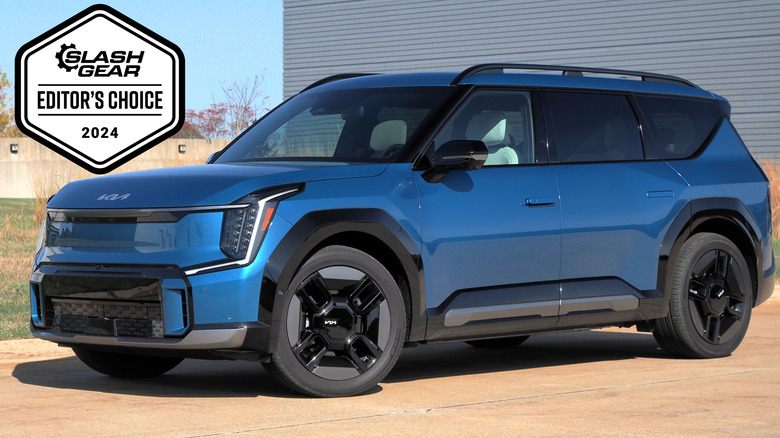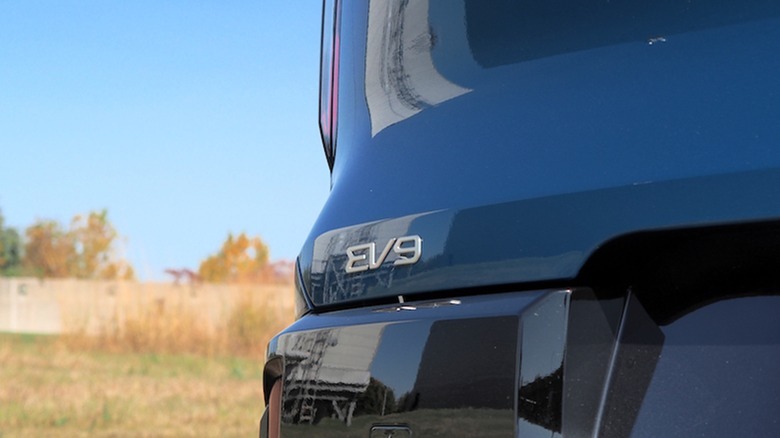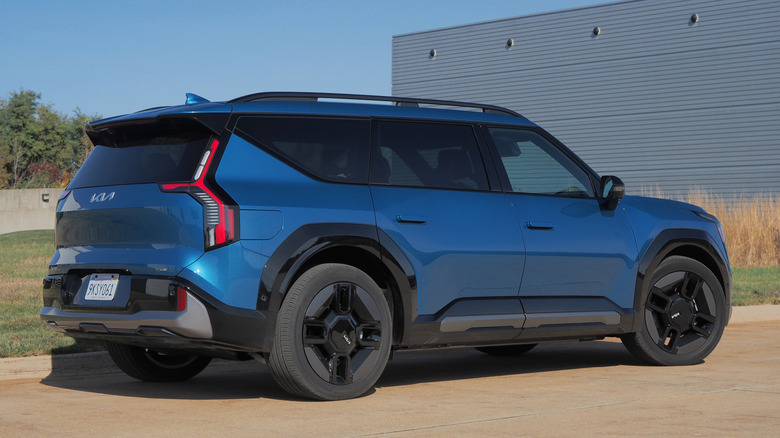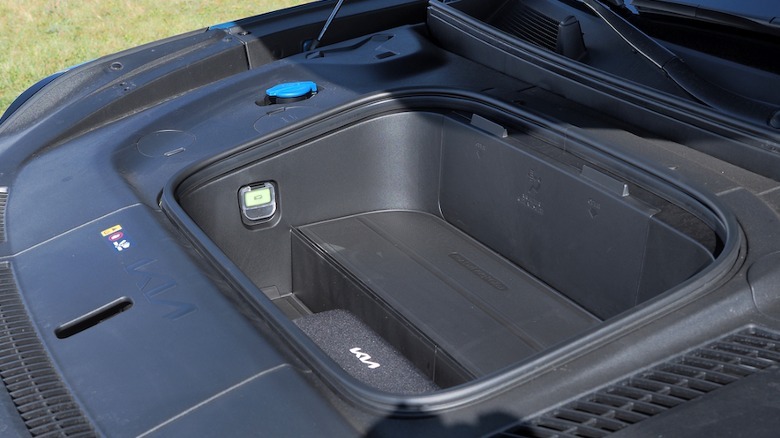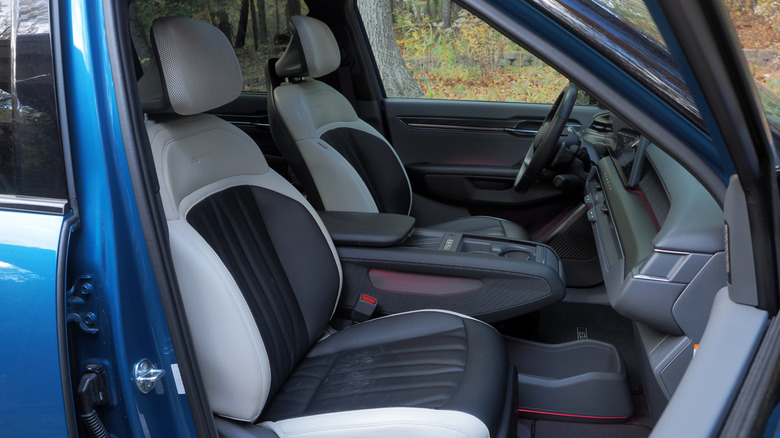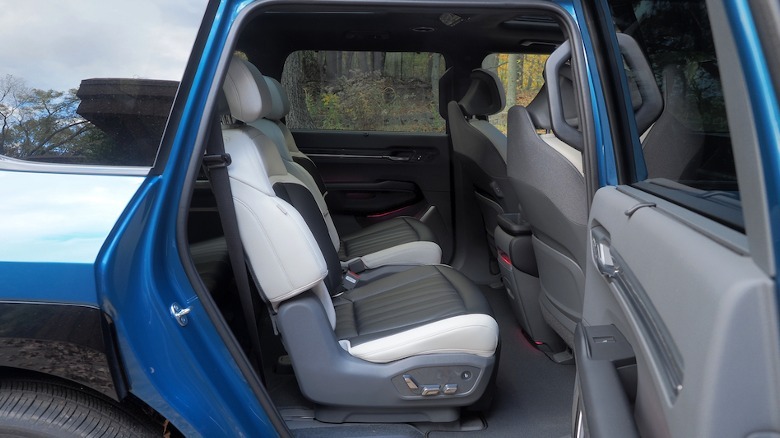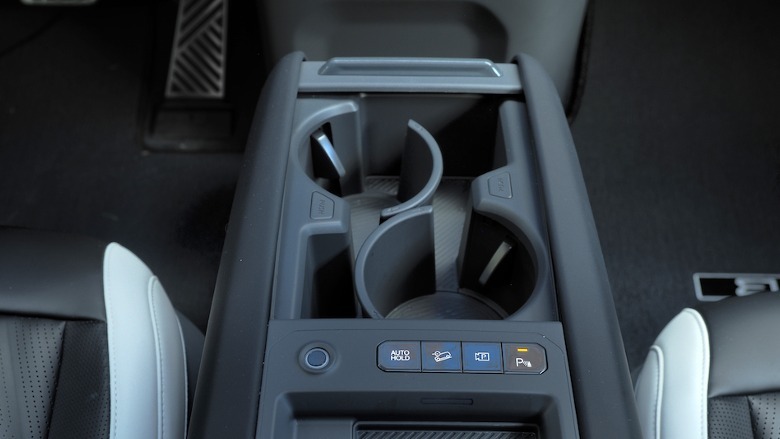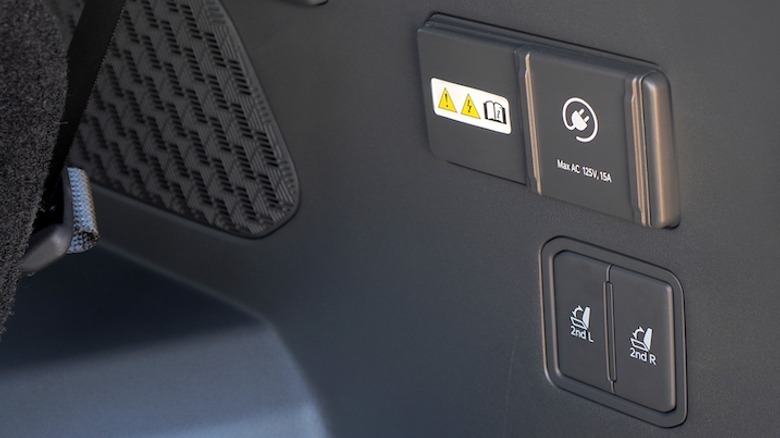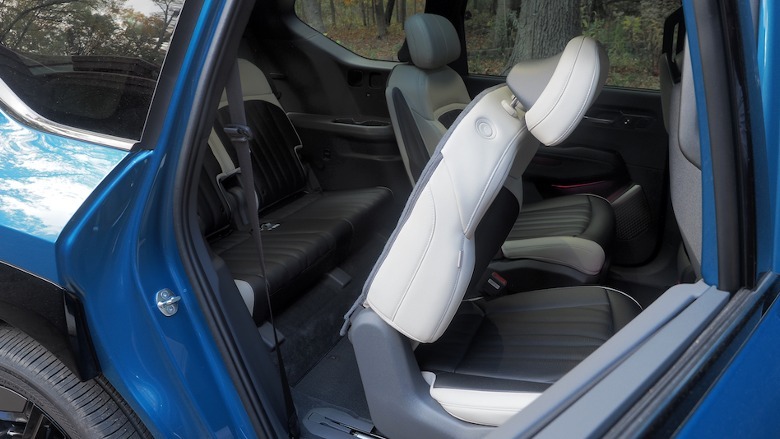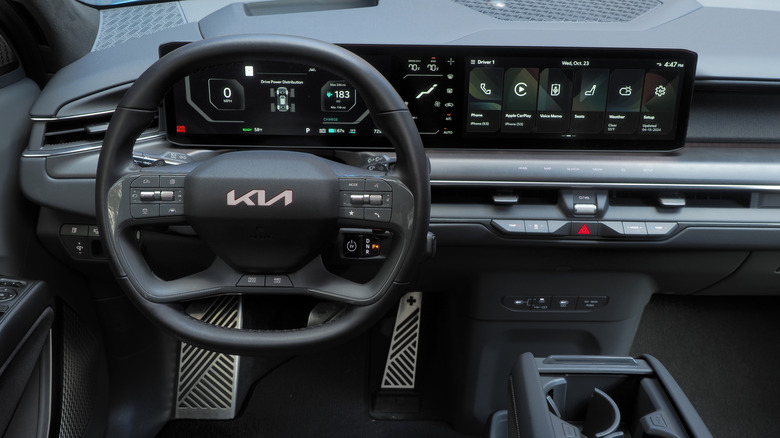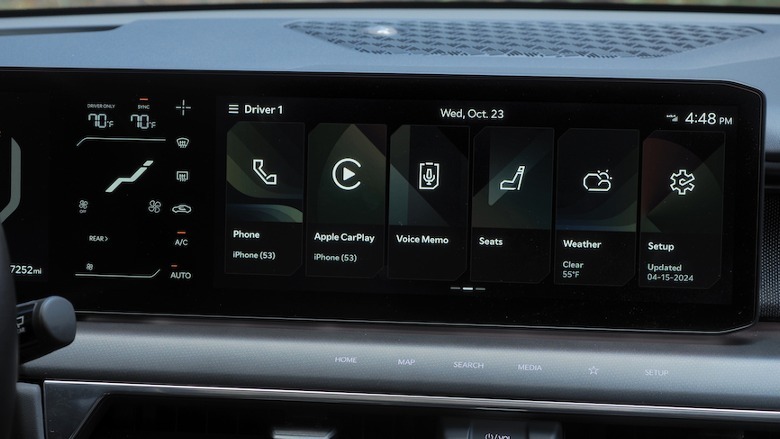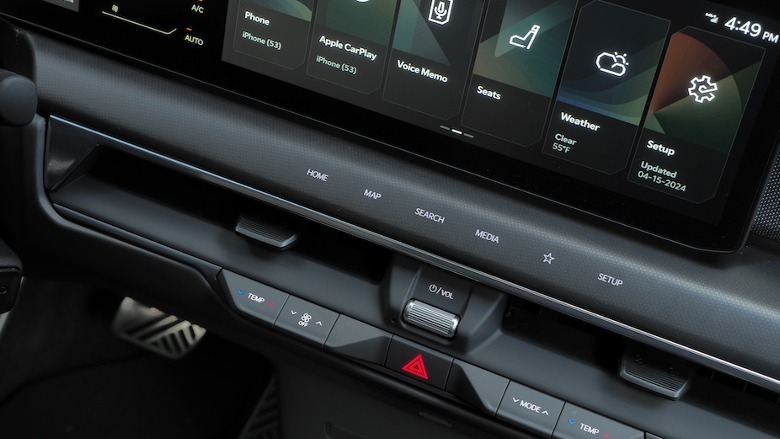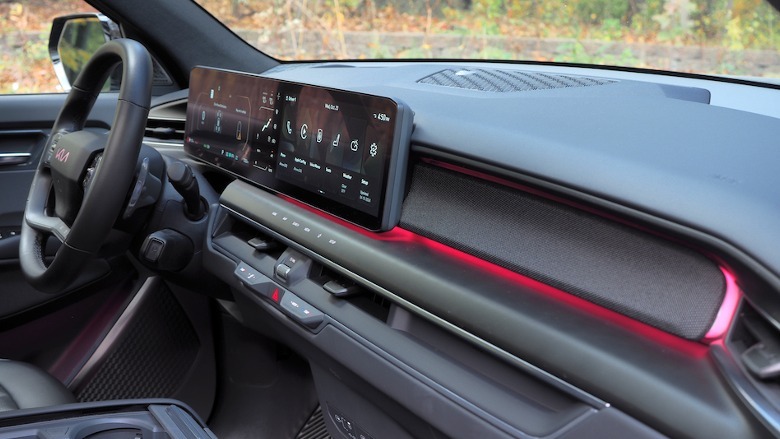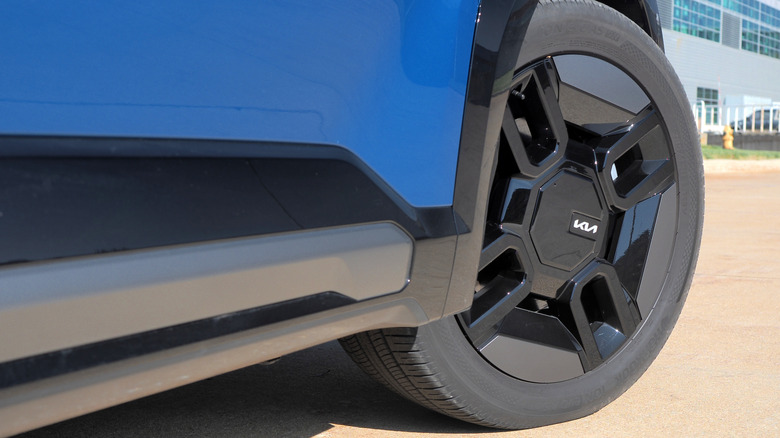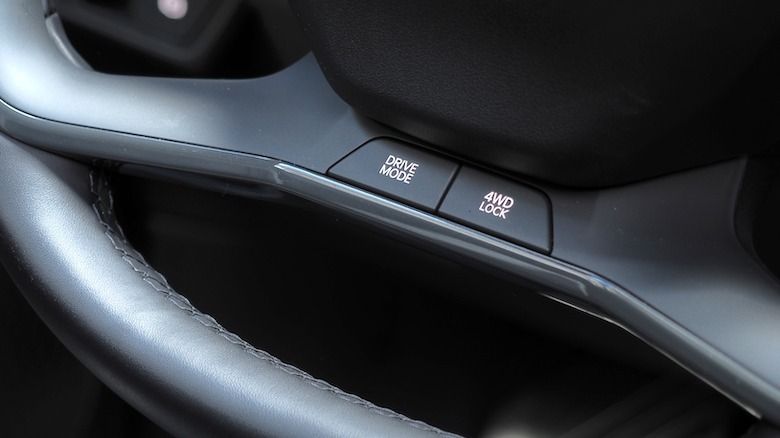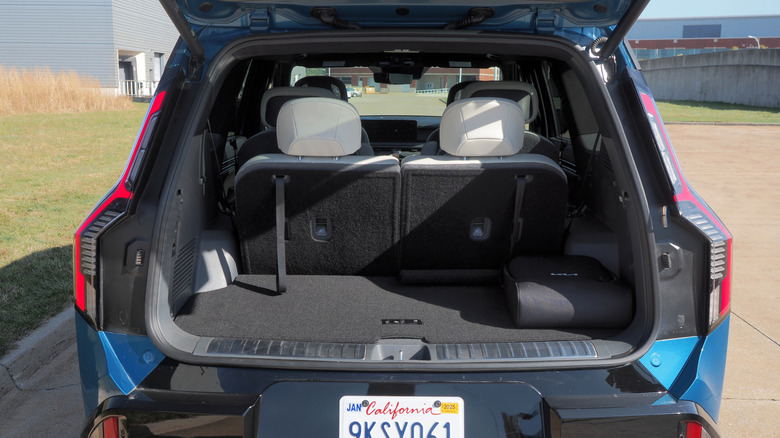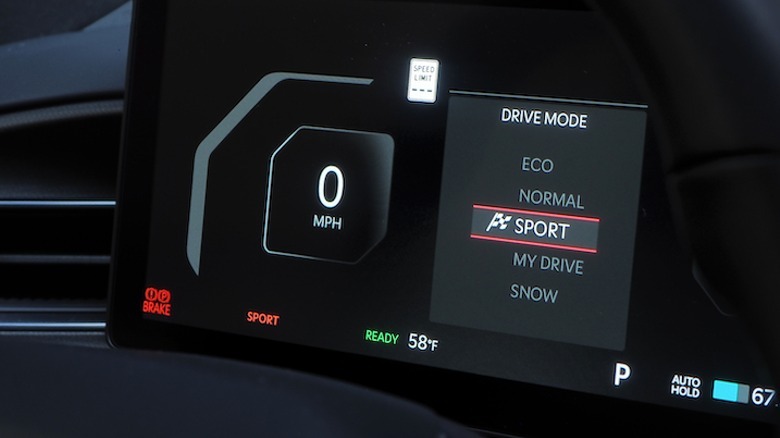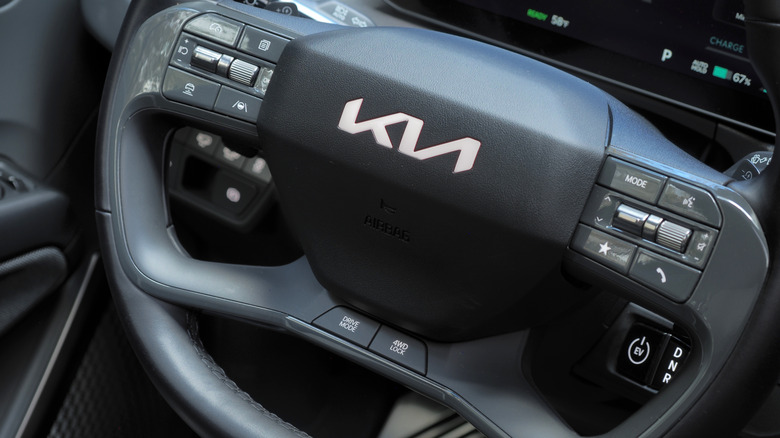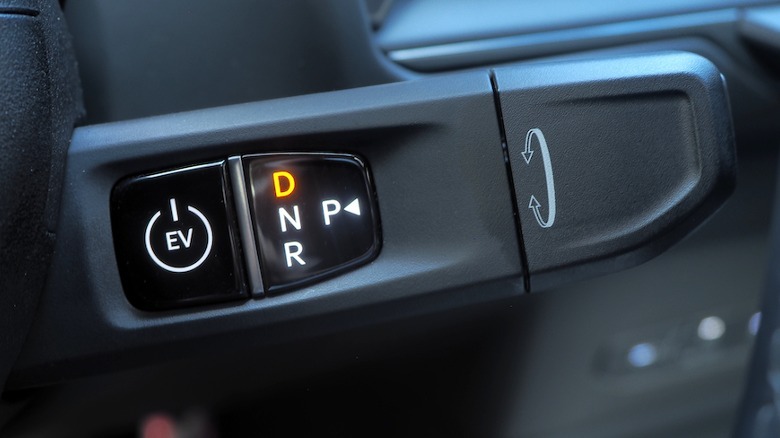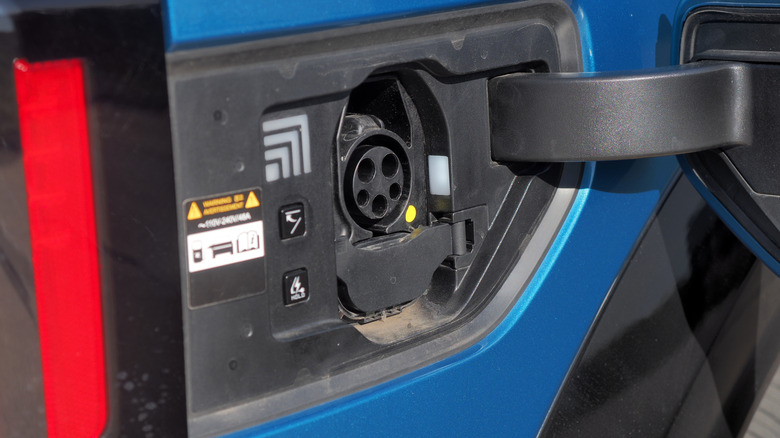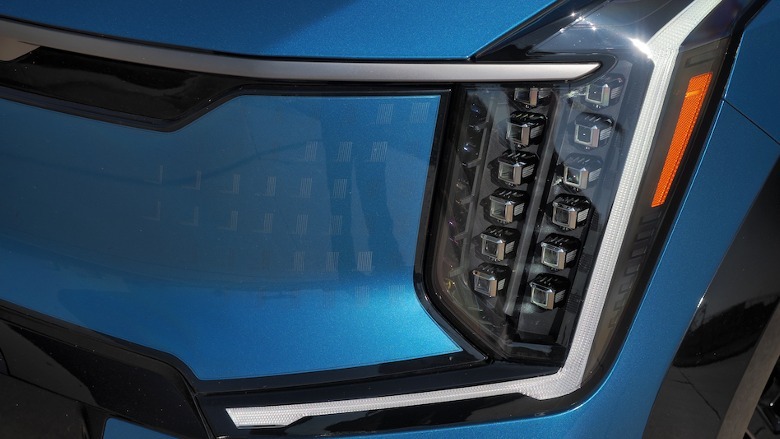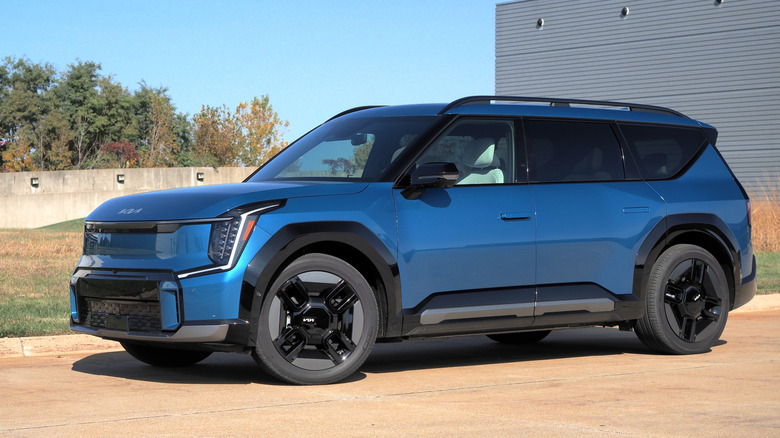2024 Kia EV9 Review: The New Standard For Three-Row SUVs
- Better range than Kia’s own estimates
- Stylish outside and spacious inside
- Plenty of standard tech & luxury
- Dashboard is touchscreen-heavy
- Distinctive design is subjective
SUVs and the spread of electrification have gone hand in hand, and for good reason. Demand for crossovers and SUVs continues to grow, potentially making it easier to nudge buyers away from internal combustion and into an EV. Meanwhile, performance expectations for SUVs tend to be more conservative, handy when you're working around a beefy battery pack. What's still far more rare, though, is an electric SUV with three rows of seating, like the Kia EV9.
In fact, there are a mere handful of such options, despite the fact that American drivers certainly love their big, capacious, and flexible SUVs. Typically, each comes with a compromise: the Tesla Model Y and Mercedes EQB are relatively affordable, but decidedly snug in the rearmost seats; a Rivian R1S or Mercedes EQS SUV lean into luxury, but with a suitably high-end price tag.
Kia could've done something straightforward, and given us an electric Telluride. Instead, the EV9 picks up the baton from the EV6 before it, intentionally opting for a more love-it-or-hate-it aesthetic. It also picks up where the Telluride leaves off in terms of pricing, justifying that in part with a healthy standard spec sheet that includes luxuries many vehicles charge extra for.
Space age style but practical with it
Like a lot of recent Kia models, the EV9 strays from what we've come to expect from its segment. There's something chunkily futuristic about it: an SUV silhouette, but with detailing borrowed from a sci-fi show. Will it date more rapidly as a result, compared to a more "classic" design? Maybe, but for now it's striking without being gimmicky.
It's reasonably practical, too. The 20.2 cu-ft trunk expands to 43.5 cu-ft with the third row folded, or 81.7 cu-ft with the second row down too. They're decent numbers, though slightly lower than a Kia Telluride (which is actually slightly shorter than the EV9).
Pop the Telluride's hood, though, and all you'll find is the engine: the EV9, in contrast, has a front storage area, or frunk. In the single-motor version of the SUV, that'll hold 3.2 cu-ft. The dual-motor version sacrifices some frunk in return for driving the front axle, though its 1.8 cu-ft of space is still enough to hold a portable charging cable (which sadly Kia makes you buy separately).
A welcoming three-row interior
Inside, Kia has six and seven seat configurations, and three seating options. The EV9 Light RWD (from $54,900) and Wind AWD ($63,900) hold the most people, with a second row bench that seats three. That's swapped for captain's chairs in the Light Long Range RWD (from $59,200), Land AWD ($69,900), and GT-Line AWD ($73,900; all MSRPs plus $1,495 destination).
Kia also has optional second row "lounge seats" with power leg rests, heating and ventilation, and power-extendable footrests, to match the first row. They're only available on the Land AWD and GT-Line AWD, as a $2,000 upgrade.
Space in the first and second rows is plentiful, for both people and their accumulated stuff, and the lounge seats are mighty comfortable for road trips. There's a sizable center console with two levels of storage bins, accessible by those in both rows — it slides forward and back in the upper trims — along with well-sized door bins. Along with Kia's healthy sprinkling of USB-C ports — a total of seven spread around the cabin — all trims get a front wireless charger and two 110V AC outlets, one in the second row and another in the trunk.
Space in the third row is reasonable, though as with many three-row SUVs, not excessive. There's between 29.9 and 32 inches of legroom, interior configuration depending; a Telluride, in contrast, lands at 31.4 inches.
The EV9 has more headroom and about the same shoulder room, but less hip space; of course, if you want something electric and truly adult scale across all three rows, you'll need to look to the VW ID. Buzz. Accessing the Kia's rearmost seats, at least, is easy thanks to the second row both folding and sliding forward.
Luxury features from the segment above
All EV9 trims get a trio of dashboard screens: a 12.3-inch digital cluster for the driver, a matching 12.3-inch center touchscreen for the infotainment, and a 5-inch screen to adjust the climate control sandwiched in-between them. Kia's infotainment system — which has wireless Apple CarPlay and Android Auto support — is easy to use, and there's a row of touch-sensitive shortcuts below it to jump between the key sections.
I found the steering wheel did partially block my view of the climate control touchscreen, however, though Kia does at least have physical switchgear for temperature and fan speed.
Only the flagship GT-Line trim gets a head-up display; it, and the Land trim, swaps the standard 8-speaker audio system for a 14-speaker Meridian system. Kia's app is standard across the board, with support for remotely monitoring charging, and adjusting preconditioning of the cabin (that way, for instance, you can have the EV9 warm up while it's still plugged in).
All trims get heated and ventilated front seats; Wind, Land, and GT-Line add a heated steering wheel, while Land and GT-Line get heated and ventilated second row seats. Dual sunroofs are standard on the upper three trims, but Kia doesn't have a leather upholstery option, only various finishes of its synthetic hide.
Performance ranges from fine to feisty
With a near-$20k gulf between Kia's most affordable EV9 and its most expensive, there's unsurprisingly a pretty considerable delta in performance, too. The rear-wheel drive Light and Light Long Range have 215 and 201 horsepower, respectively, and 258 lb-ft of torque from their single electric motors. That's sufficient for a laissez-faire 0-60 mph time of 7.7 or 8.8 seconds, respectively.
Things get far more interesting with the second motor added in. The Wind and Land both have 379 horsepower and 443 lb-ft of torque, the latter temporarily jumping to 516 lb-ft in Boost mode (and in the process cutting the 0-60 time from 5.7 to 5.0 seconds). In the GT-Line you see here, the 516 lb-ft is permanent.
With curb weights ranging from around 5,100 pounds (Light RWD) to a beefy 5,900 pounds (GT-Line AWD) those numbers don't translate to sports car levels of pace. The GT-Line is certainly spritely from a standing start — gas-guzzling SUVs and trucks are comfortably left in the afterglow of the EV9's complicated rear light clusters — and swift enough for a three-row family hauler. Perhaps, though, it's the more potent models' potential for 5,000 pounds of tow capacity (versus as little as 2,000 pounds in the RWD versions) that should be more notable.
It hides its weight well
All trims get independent MacPherson multi-link front suspension with coil springs, and 5-link MacPherson at the rear. Self-leveling rear air suspension is standard on the GT-Line and an option on the Land trim; it promises to even out ride and ride-height depending on what you have onboard.
The EV9 — as is usually the case with electric vehicles — has its suspension dialed in on the firm side, to better manage the weight. A low center of gravity and the standard stabilizer bars front and rear avoid the roll and understeer you might predict from a big SUV, particularly a slab-sided one like this. Tap the Drive Mode button on the bottom of the steering wheel until you get to Sport, and the GT-Line is far more eager to drain its battery.
It's charming, in the way EVs are usually charming from behind the wheel. Kia offers multiple levels of regen, including a one-pedal mode (which, annoyingly, doesn't persist when the EV9 is restarted), and the transition from there to physical brakes is smooth. AWD models get a Snow mode along with Normal, Eco, Sport, and the driver-customizable My Mode, and clearly Kia expects them to be the mainstays in wintery states given they're also the only trims to get a heat pump for improved cold-weather efficiency.
The EV9 beats its range estimates
Though the cheapest EV9 gets a 76.1 kWh battery (rated for 230 miles) to keep the cost of entry low, all other trims see that bumped up to a 99.8 kWh pack. In Light Long range RWD form, that's enough for an EPA-rated 304 miles; the all-wheel drive Wind and Land see it dip to 280 miles, and the more permanently-potent GT-Line trims it to 270 miles.
They're solid numbers in a segment with little competition, at least for the moment. Tesla's three-row Model X AWD starts at over $83k — about $10k more expensive than the most expensive EV9 trim — with a claimed 335 mile range. The ID. Buzz may be retro-adorable, but it's only rated at 234 miles in RWD form, or 231 miles with AWD.
As always, how you drive makes a significant difference to real-world range. The EV9 shows best and worst case estimates along with the standard range remaining read-out: at 100%, for example, the Kia suggested I could drive as far as 375 miles, or as little as 271 miles. Although the EPA estimate for the GT-Line is around 2.4 miles per kWh, I easily bested that and saw 2.8-3.0 depending on how much time I spent on the highway.
Fast charging and plenty of safety tech
When it comes to charging, meanwhile, Kia quotes almost nine hours to take the larger battery from 10-100%, when plugged into a Level 2 (240V/11kW) charger such as many people have installed at home. Find a public DC fast charger, however, and the EV9 supports up to 210 kW rates (or 235 kW for the smaller battery model). That could mean 10-80% in under 25 minutes.
As for safety tech, that's another healthy showing for the big Kia. Blind spot warnings and assistance are standard (Land and GT-Line trims get Kia's camera view beamed to the driver display when you hit the turn signal), as are forward collision warnings with assistance for everything from pedestrians and cyclists, through traffic turning or crossing at junctions, to potential oncoming and side lane crashes.
All get front and rear parking sensors, and rear cross-traffic collision avoidance assistance; Land and GT-Line add side sensors and reverse parking collision avoidance assist. The GT-Line can be moved in and out of a parking space remotely, from the key fob. Highway Driving Assist 2 (HDA 2), Kia's hands-on driver assistance which can hold the lane and maintain speed with surrounding traffic, is standard on all trims. Weirdly, only the top two trims get a 360-degree camera, and it's not even available as an option on the cheaper models.
2024 Kia EV9 Verdict
Pleasant as the Kia EV9 GT-Line is, saving $10k and opting for the Wind AWD trim feels like the sensible route. That gets you seating for seven, plenty of creature comforts including the dual sunroofs, the efficiency-aiding heat pump, and of course the reassurance of all-wheel drive in its longest-range form. At $65,395 inclusive of destination, it's cheaper, more powerful, and will drive further on a charge than VW's AWD ID. Buzz.
Does it have the personality of the electric bus? No, but for the typical family I'm not sure that's always going to be worth the trade-off. Where Kia's EV SUV succeeds is in its balance of thinking-differently without being odd for its own sake. It leans into the advantages of electrification without demanding undue compromise, and while Kia could've arguably taken the easy route in an option-starved segment, instead it created something worthy of being called the new benchmark.
